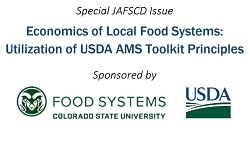Evaluating the Economic Impacts of Farm-to-school Procurement
An Approach for Primary and Secondary Financial Data Collection of Producers Selling to Schools
DOI:
https://doi.org/10.5304/jafscd.2019.08C.002
Keywords:
Farm-to-School, Food Systems, Economic Impact, Local Food Systems ToolkitAbstract
According to the U.S. Department of Agriculture’s (USDA) Farm to School Census, during the 2013–2014 school year, 42% of all U.S. schools (5,254 districts including 42,587 schools) participated in farm-to-school activities. These programs included 23.6 million children and purchased almost US$800 million of locally procured food items (USDA Food and Nutrition Services [USDA FNS], 2015). One of the purported benefits of farm-to-school procurement is that it strengthens the local economy by providing expanded market access for local farms and ranches. Despite the claims of positive economic impact, there is limited research to support this. This paper presents a framework for evaluating the economic impacts of farm-to-school programs, adapting the USDA’s “Local Food Economics Toolkit” for this specific context. The approach combines primary and secondary data to customize an input-output model, reflecting the complex supply chains that link producers and schools. Additionally, to illustrate the approach, we summarize the findings from two case studies of local food procurement by schools between 2016 and 2017.
See the press release for this article.
Metrics

Downloads
Published
How to Cite
Issue
Section
License
The copyright to all content published in JAFSCD belongs to the author(s). It is licensed as CC BY 4.0. This license determines how you may reprint, copy, distribute, or otherwise share JAFSCD content.













